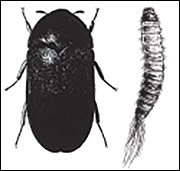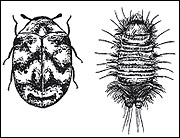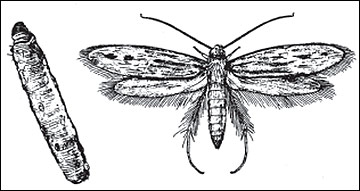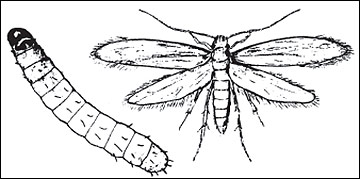Carpet beetles and clothes moths can cause serious damage to fabrics, furs and carpets, among other items. This publication describes the carpet beetle and clothes moth species most commonly found in Missouri homes.
Carpet beetles
Carpet beetles belong to the beetle family Dermestidae. The adults are harmless and feed on plant pollen exclusively. It is the larva, the growing stage, that causes damage by feeding on items primarily of animal origin. Carpet beetles will also attack other materials, such as cotton and synthetic fibers if these fabrics are soiled with human perspiration, body oils, beer, milk or fruit juice. Some carpet beetles may become pantry pests by invading cereal grain products.
Black carpet beetle
The black carpet beetle, Attagenus unicolor, is one of the most common and widespread carpet beetles in the United States (Figure 1). Adults are black with brown legs, somewhat shiny, oval and about 1/8 to 3/16 inch long.
The larva is brown and carrot-shaped with a long brushy tail of brown hairs, and up to 1/2 inch long at maturity.
Black carpet beetle larvae will eat almost anything of animal origin, such as wool, hair, feathers, leather, furs, stuffed trophy animals, dead insects or silk. They may also feed on cereal grain products and nut meats. Development from egg to adult beetle takes from nine months to two years.
 Figure 1
Figure 1
Carpet beetle adult, left, and larva, right.
Varied carpet beetle
The varied carpet beetle, Anthenus verbasci, is the most commonly encountered carpet beetle in Missouri. The adult beetle is a rounded oval, convex and about 1/8 inch long. The wing cover surface is patterned with brown, yellow and white scales. The underside of the body is covered with fine, long grayish scales. Larvae are about 3/16 inch long at maturity.
The larvae are small and appear to have alternating light and dark brown stripes across the body. They are very fuzzy and have three pairs of dark brown bristly bundles located somewhat to each side on the segments near the rear end.
The varied carpet beetle larvae, like the black carpet beetle larvae, feed on anything of animal origin, including wool, hair, feathers, leather, furs, stuffed trophy animals, dead insects or silk. They are also often associated with abandoned bird nests. Development takes from nine months to one year.
 Figure 2
Figure 2
Varied carpet beetle adult, left, and larva, right.
Other species
Another species found less often in Missouri homes is the common carpet beetle, Anthrenus flavipes. It is similar in appearance and feeding habits to the varied carpet beetle.
Clothes moths
Clothes moths belong to the moth family Tineidae. The larval, or caterpillar, stage damages items of animal origin, such as wool, fur, silk and feathers. The adult moths do not feed. They are rarely seen because they tend to hide in the dark during daylight. The Indian meal moth, a common pantry pest, flies about during daylight and is often mistaken for one of these moths.
Casemaking clothes moth
The casemaking clothes moth, Tinea pellionella, is a buff-gray color and about 1/4 inch long with its wings folded along the body. Each front wing has three somewhat indistinct darker spots of scales.
The larva is creamy white with a brown head. It produces a silken tubelike case it lives in and carries around for protection. The head and legs are exposed only during feeding and movement. This case is camouflaged with bits of the material on which the larva has been feeding. The larva is about 1/2 inch long at maturity.
Development from egg to adult is highly variable, depending on available food and environmental conditions. It can take as little as a month.
 Figure 3
Figure 3
Casemaking clothes moth larva, left, and adult, right.
Webbing clothes moth
The webbing clothes moth, Tineola bisselliella, is about 1/4 inch long. It is a uniform buff color and has a small tuft of red hair on the top of its head.
The larva is whitish with a brown head. It produces a silk-lined "tunnel" as it eats through or on the surface of a fabric. The moth is about 1/2 inch long at maturity. As with the casemaking clothes moth, its developmental time is highly variable, depending on available food and environmental conditions, but can take as little as month.
 Figure 4
Figure 4
Webbing clothes moth larva, left, and adult, right.
Control measures
Prevention
Vacuum wool carpets often enough to prevent the accumulation of hair, lint and other carpet beetle food materials. Remember to vacuum under seldom-moved furniture and along baseboards. Upholstered furniture, air ducts and other lint-accumulating sites also need this cleaning.
Dry clean or wash woolens and place them in tightly sealed containers for summer storage. Moth balls (naphthalene) or PDB (paradichlorobenzene) crystals may help prevent carpet beetles and clothes moths from invading the articles. Use paper to avoid direct contact between chemical and the articles. Avoid long-term and undisturbed storage of susceptible materials.
Help deter carpet beetle invasion by removing abandoned bird nests and bee and wasp nests from attics, wall voids and eaves. Also, remove dead insects from light covers, window sills and other places they accumulate.
Chemical control
Treat infested carpet or upholstered furniture with a ready-to-use insecticide aerosol or dust that is labelled for use indoors. Do not treat clothing.
When treating rugs that are not fastened to the floor, treat the top and bottom surfaces. In rooms with wall-to-wall carpeting, treat along all baseboard-to-carpet contact areas. These beetle larvae like undisturbed locations, so treat all carpet underneath furniture and the underside of upholstered furniture.
Stuffed animal trophies may require an additional internal spray or dusting.
Do not allow children or pets to have contact with treated surfaces until they are thoroughly dry. Staining or running of colors is a possibility with certain fibers. Test a small, hidden area with the spray product to check for any adverse effects before applying the chemical to the entire area.